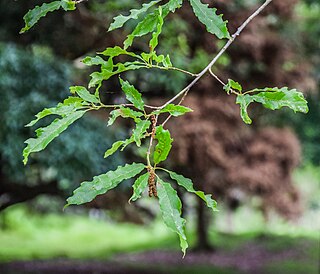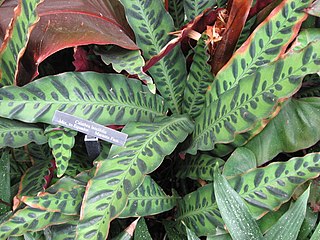
Uncaria is a genus of flowering plants in the family Rubiaceae. It has about 40 species. Their distribution is pantropical, with most species native to tropical Asia, three from Africa and the Mediterranean and two from the neotropics. They are known colloquially as gambier, cat's claw or uña de gato. The latter two names are shared with several other plants. The type species for the genus is Uncaria guianensis.

Quercus lancifolia is a species of oak found in Central America and Mexico.

Anemonoides lancifolia, the lanceleaf anemone or mountain thimbleweed, is an herbaceous plant species in the family Ranunculaceae. The genus occurs in the Southeastern United States. Plants grow 20 to 30 cm tall, growing from a horizontally-orientated rhizome, flowering mid-spring to early summer. The flowers have white sepals that are 12–20 mm long. This species much resembles Anemonoides quinquefolia, of which it was formerly considered a subspecies, except that it is larger growing. After flowering, fruits called achenes are formed in a small cluster; each achene is 3.5–5 mm long, lacks wings and has a straight or partly curved beak that is 1–1.5 mm long.
Horsfieldia lancifolia is a species of plant in the family Myristicaceae. It is a tree endemic to Sulawesi in Indonesia.

Anemonoides is a genus of flowering plants in the buttercup family Ranunculaceae. Plants of the genus are native to the temperate regions of the Northern Hemisphere, on the continents of North America, Europe, and Asia. The generic name Anemonoides means "anemone-like", a reminder that many of the species were formerly included within the genus Anemone.

Guihaia is a genus of three species of dioecious palms found in China and Vietnam. Perhaps its most distinctive characteristic is that it is the only palm with palmate leaves that has reduplicate (A-shaped) leaf folds. All other palmate leaves have induplicate (V-shaped) leaf folds. Guihaia lancifolia has undivided leaves.

Goeppertia insignis, the rattlesnake plant, is a species of flowering plant in the Marantaceae family, native to Rio de Janeiro state in Brazil.
Agnesia is a genus of herbaceous South American bamboo in the grass family.
Arberella is a genus of Neotropical bamboo in the grass family.
- Arberella bahiensis - Venezuela (Amazonas), Brazil (Bahia)
- Arberella costaricensis - Costa Rica
- Arberella dressleri - Panama
- Arberella flaccida - Colombia, French Guiana, Suriname, Brazil
- Arberella grayumii - Costa Rica
- Arberella lancifolia - Panama
- Arberella venezuelae - Venezuela (Amazonas)
Droogmansia is a genus of flowering plants in the legume family, Fabaceae. It belongs to the subfamily Faboideae. It includes 22 species which are native to tropical Africa, ranging from Guinea to Tanzania, Mozambique, Zimbabwe, and Angola.
Vriesea lancifolia is a species of flowering plant in the Bromeliaceae family. It is endemic to Brazil.

Sagittaria lancifolia, the bulltongue arrowhead, is a perennial, monocot plant in the family Alismataceae, genus Sagittaria, with herbaceous growth patterns. It is native to the southeastern United States. It is known from every coastal state from Delaware to Texas. The species is also considered native to Mexico, Central America, the West Indies and northern South America. It has become naturalized on the Island of Java in Indonesia.

Halothamnus lancifolius is a species of the plant genus Halothamnus, that belongs to the subfamily Salsoloideae within the family Amaranthaceae,. It occurs in Southwest Asia.
Kopsia pauciflora is a tree in the family Apocynaceae. The specific epithet pauciflora means "few-flowered".
Madhuca lancifolia is a tree in the family Sapotaceae. The specific epithet lancifolia means "lance-shaped leaves".
Micrechites lancifolius is a species of flowering plants in the family Apocynaceae, It is a liana native to Peninsular Malaysia, Borneo, and Sumatra.
Liatris lancifolia is a species of flowering plants in the family Asteraceae native to the prairies of central and western North America, known by the common names lanceleaf blazing star and Great Plains gayfeather.
Halerpestes is a genus of flowering plants belonging to the family Ranunculaceae.
Phyllanthera is a genus of flowering plants belonging to the family Apocynaceae.
Carex lancifolia is a tussock-forming species of perennial sedge in the family Cyperaceae. It is native to parts of central China.







